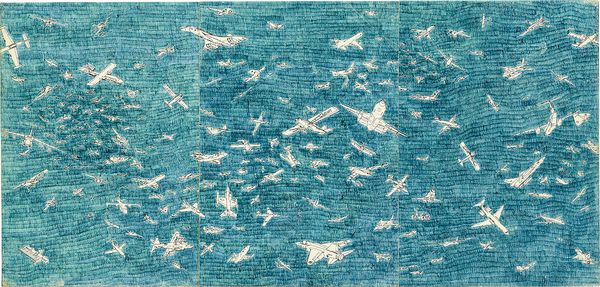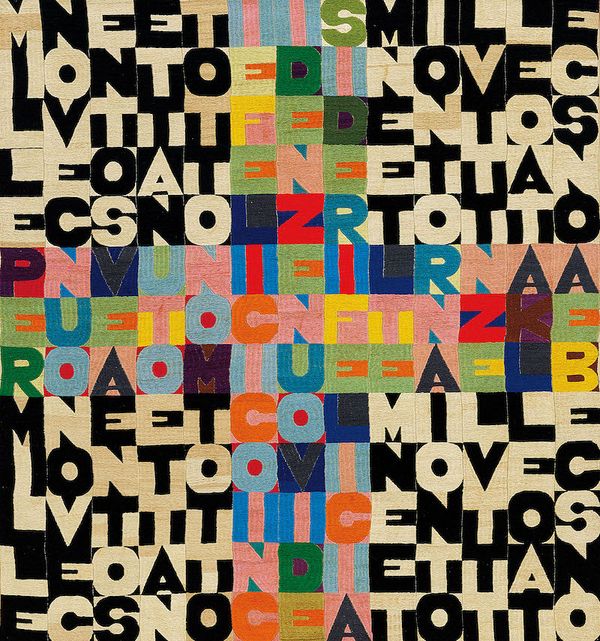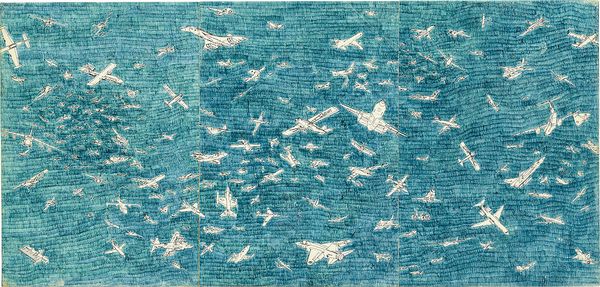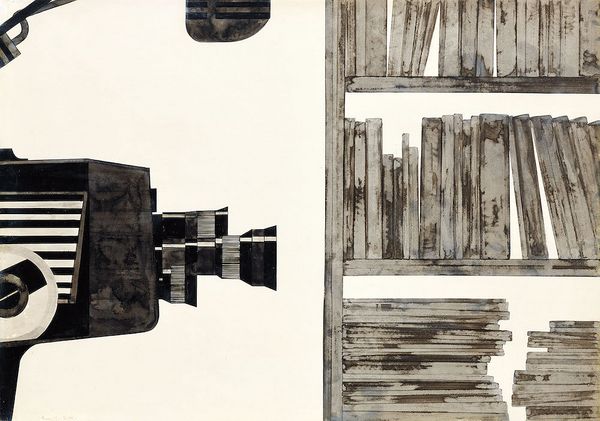Alighiero Boetti, Aerei, 1983.
Once defined by Hans Ubrich Olbrist as the European Andy Warhol, Alighiero Boetti, born in 1940 in the Italian city of Turin, was one of the most influential international artists of his generation. His first sculptural works from the late 1960s are associated with the Arte Povera movement, with whom he shared a preference for basic matter and anti-classical style. However, being more interested in concepts than materials, he soon deviated from it. Until his premature death in 1994, he went on to create a unique artistic narrative through play, poetry, measure, numbers, order and disorder, that he combined with material diversity and conceptual complexity, always expressed with extraordinary visual beauty. The artist did not follow a linear evolution in his practice, but rather focused on several threads that kept recurring throughout his life. The present seminal works exemplify five of them and take the viewer in a unique experience of what was both Boetti’s passion and biggest artistic achievement, the ability to travel in space and time.
Alighiero Boetti, Senza titolo (1977 per 1978), 1977-78.
The first work made by Boetti representing a cross, Senza titolo (1977 per 1978) is a mesmerising large-scale early example of the artist’s celebrated tapestries, the Arazzi. The artist’s textile works began in the 1970s, when he traveled to Afghanistan and started to collaborate with local embroiderers, first in Kabul and, after the Soviet invasion in 1979, in Peshawar, Pakistan. Merging linguistic and numeric systems into a glimmering play of colour and pattern, the present work is constituted by individual letters arranged in an order that seems random. This chaos is only apparent and hides a highly logical premise, only revealed to those able to find harmony in dissonance. The four black and white squares, read from top to bottom in sequential vertical columns for the two on the left and in horizontal rows for the two on the right, spell out the date of its creation, "millenovecentosettantotto," 1978 in Italian. This was a seminal year in the artist’s life, with his first retrospective curated by Jean-Christophe Amman taking place at the Kunsthalle in Basel and his participation at the Venice Biennale. The central bright-coloured cross reads "per nuove autonomie," for new independences, "felici coincidenze," happy coincidences, "nuovi desideri," new desires, "felici alternanze," happy variations, "a KL," to Kabul, an homage to the city that he deeply loved, and "A E B," both his signature and double identity -Alighiero, the private person, and Boetti, the public one, shaman and showman at once. This work profoundly emblematises all the main elements of the artist’s vision, conveyed with full force.
Alighiero Boetti,Vedere i Laterali, circa 1977.
The Biro series started in the 1970s, when Boetti used a ball point pen, a common, quintessentially inexpensive object, to fill entire sheets of paper with ink, that later were green, red and black too. This early work from 1977, titled Vedere i Laterali, "Viewing the Sides," is a triptych of three sheets of paper covered in ballpoint. The biro creates a cryptic message through the space of the alphabet on the left hand and the seemingly arbitrary arrangement of white commas throughout the three panels, that, when read from sequentially from left to right, spell out the title itself.
‘In his universe of meaning, ballpoint pens also served to dispel better the distinctive, unique, and inimitable act in the sea of collective and anonymous signs that is the basic intention of Boetti’s art, these works’ surfaces appear indented by commas, small white zones, each of which correspond to one of the letters of the alphabet, it is connecting comma and letter that the phrase the work conceals finally emerges. The simple mechanism of deconstructing language actually causes the rebirth of all languages, words, signs, painting and so on.’ Each biro work contains panels that were done by different people, often students, and most times a man and a woman. In the eclectic portfolio of works by Alighiero Boetti, the biro can easily be compared to the equally important and parallel tapestries. Indeed, what the embroidery represents for an Afghan is what the ballpoint pen constitutes for a Westerner -both are the media that the entire community uses to speak, the expression of a collective memory.
Alighiero Boetti, Aerei, 1983.
The current work is an example of the Aerei, “airplanes,” series that began in 1977 when Boetti started collaborating with the illustrator Guido Fuga. Here the ballpoint pen symbolizes the air in which fly dozens of different airplanes, temporary and transient objects that may suddenly disappear beyond the frame, lost like Boetti in infinite possible journeys. The repetitiveness of the Aerei embodies the beauty of the compositional variety and its limitless possibilities, so important to the artist’s research. In line with the rest of his work, indeed, they may appear as disoriented and chaotic, yet are classifying and reasoned. The theme of time is also present, as the airplanes represent a meditation on the concept of movement and stillness through the human body and mind.
Alighiero Boetti, Senza titolo, 1965.
Senza titolo is an iconic example of a series of around fifty drawings that Boetti made with India ink in 1965 to represent industrial tools, such as combs, tumblers and bottles, desk lamps, microphones or cameras. The execution is strongly bidimensional and the objects, meticulously realized by the hand of artist, convey a feeling of a metaphysical restlessness and estrangement. The film camera in the present works seems to go beyond the pictorial plane and to involve the viewer in another world, parallel and maybe more authentic than the real one.
Alighiero Boetti, Faccine, 1977.
The need of Boetti for a collective participation to his work was also pursued with the Faccine, a series of offset prints that he gave to the public, sometimes children in schools, to paint as they liked. The present example belongs to the first edition from 1977, bigger than the later ones and, unlike them, stamped on the front. It was probably colored by its initial owner, with an act of mutual creation that embodies the essence of Boetti’s vision of the world, that will eternally benefit from his art and go on also without him.
Discover More from Out of the Blue: The Enea Righi Collection >
Recommended Reading
A Tale of Three Artists: Gentileschi, Kollwitz, Emin >
In Conversation with Collector Enea Righi >






